 The following are foods to either feed with caution or to completely avoid feeding your pet rats. The information below is based on my personal experience along with internet research. Please note this is not to be considered an exhaustive list, just a guideline.
The following are foods to either feed with caution or to completely avoid feeding your pet rats. The information below is based on my personal experience along with internet research. Please note this is not to be considered an exhaustive list, just a guideline.
Apple Seeds contain a deadly cyanide derivative. The fruit of the apple, however, is fine for rats to eat.
The pit, rind, and skin of Avocados are toxic. The fruit of avocados is fine as long as it’s ripe. However, any part of the fruit in contact with the pit or the rind should not be fed to pet rats. Nutritious but also high in fat, avocado can be helpful for rats who need to gain weight.
Green Bananas can inhibit starch-digesting enzymes. Bananas that have ripened are fine to feed your rats.
Beets are high in oxalic acid which can cause urinary crystals to form. They are also high in nitrates which can result in an increased cancer risk for rats when fed frequently and in large quantities.
Carbonated Beverages should be avoided. Once rats ingest a food, they don’t have the option of vomiting or even burping. Instead the food has to pass through their entire gastrointestinal system which could be very uncomfortable for your rat.
 Celery is stringy which can cause choking in rats. It’s also high in nitrates which can increase cancer risks in rats.
Celery is stringy which can cause choking in rats. It’s also high in nitrates which can increase cancer risks in rats.
Chocolate contains stimulants that can lead to heart failure or neurological poisoning if fed in high quantities. Some say very small bit of chocolate is okay and that it can actually temporarily alleviate respiratory distress. I myself, though, wouldn’t feed chocolate to my rats…..to me, it just doesn’t seem like a good idea!
Citrus Juice can cause kidney damage and kidney cancer in male rats only. Citrus juice is dangerous due to d-limonene, a chemical contained in the oil of the rind, which is extracted into the juice during squeezing. If a male rat consumes too much d-limonene, it causes a specific protein found only in male rat’s kidneys to build up which can then result in tumors. It’s okay for females to consume citrus juice since they don’t have this protein in their kidneys. Male rats can eat pieces of the sections of an orange, just make sure to wash the orange skin oil off after peeling it. Also, to prevent choking, make sure there aren’t any of the stringy fibrous materials attached to the pieces you give a male or a female rat. Some people prefer not to feed male rats oranges at all.
Collard Greens – High in nitrates, cancer risk if fed frequently and in large quantities.
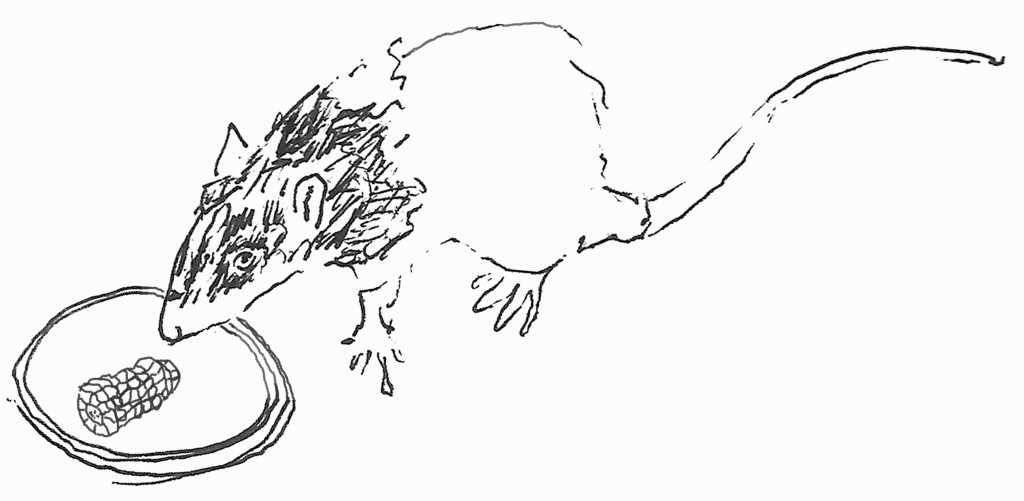 Corn – Dried corn can contain high levels of fungi which have been shown to cause liver, kidney and colon cancer in rats. Corn also contains high levels of both nitrates and amines. These two compounds can combine in the stomach to form nitrosamines which are carcinogenic. Fresh corn is fine, although you’ll probably want to keep it to a minimum. If your rats are being fed lab blocks, it is probably best to avoid brands which have corn as the first ingredient.
Corn – Dried corn can contain high levels of fungi which have been shown to cause liver, kidney and colon cancer in rats. Corn also contains high levels of both nitrates and amines. These two compounds can combine in the stomach to form nitrosamines which are carcinogenic. Fresh corn is fine, although you’ll probably want to keep it to a minimum. If your rats are being fed lab blocks, it is probably best to avoid brands which have corn as the first ingredient.
Eggplant: High in cancer-causing nitrates for rats if fed frequently and in large quantities.
Fats from Meats: Rats do not have a gall bladder which, in humans, is where the bile acids produced by the liver are stored. Without a gall bladder, the amount of bile acids available for digestion at any given time is greatly reduced.
Iceberg Lettuce: Contains no nutrients and often causes diarrhea due to its high water content
Licorice: Has been thought to contain a neurotoxin. I wouldn’t even think to feed my rats any sort of candy or sugary food anyways. I also avoid feeding them any sort of junk food such as chips or cheetos.
Mangos: Same as Citrus Juice above
Moldy food: Spoiled or moldy food can contain deadly toxins. Never, EVER, feed your rats anything that looks spoiled or smells rotten. I would be hesitant to even feed aged cheese to my rats. If you see mold growing on a food, throw the whole thing away. Don’t attempt to just cut away the moldy section. Once any part of the food is moldy, it’s a good bet the entire thing is contaminated.
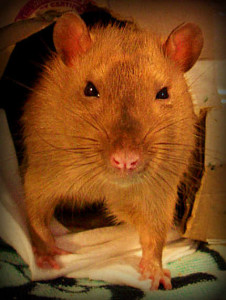
Nuts: Every once in awhile as a special treat, roasted nuts are fine. The problem with nuts, however, is they’re extremely high in fat. Rats easily gain weight and can become obese. Being overweight is not only being uncomfortable but also can lead to a host of health problems. Some people like to give their rats nuts inside the shell, thinking it’s a fun game for their rats to crack open the shell. I’ve given my rats walnuts in the shell in the past. I was amazed when I was in the same room while they were trying to break open the walnuts. It sounded like my rats’ teeth were going to crack off since they had to chew so hard on the shells. I wouldn’t recommend that anyone feed their rats walnuts, or any other nuts besides peanuts, in a shell.
Peanut Butter: It’s okay to spread a very thin layer of peanut butter on a bit of bread or to let your rats lick a small amount thinly smeared on your finger. However, if you were to give your rat a chunk of peanut butter by itself, it could cause your rat to choke.
Plum Pits: The pit of a plum contains cyanogens, which are bound molecules of sugar and cyanide. When this bond is broken, the cyanide becomes viable. Fortunately the cyanogens don’t leak into the flesh of the fruit. In fact, plums are a good source of potassium, Vitamin A and fiber.
Poppy Seeds: Can cause neurological damage, and even death.
Green Potato Skin and Eyes: Contains solanine, a toxin.
The following foods should not be fed Raw:
- Artichokes inhibit protein digestion.
- Brussels Sprouts contain thiamin-destroying anti-nutrient.
- Dry Beans can destroy vitamin A and enzymes needed to digest protein and starches and cause red blood cells to clump. Cooked beans are fine.
- Onions can cause an upset stomach and may also lead to anemia.
- Peanuts can destroy vitamin A and enzymes needed to digest protein and starches and may cause red blood cells to clump. Roasted peanuts are fine. I love giving my rats roasted peanuts still in the shell. They enjoy opening them and finding the nuts inside! Just be careful not to feed too many because they are very high in fat. I would also not want to feed too many since even roasted peanuts can easily become moldy.
- Red Cabbage contains thiamin-destroying anti-nutrient.
- Rhubarb contains high levels of calcium-binding oxalates.
- Raw Sweet Potato can form cyanide in the stomach. However, a baked sweet potato is chock-full of nutritional value.
- Raw bulk Tofu can contain bacteria. Packaged raw tofu is safe.
Radishes are high in nitrates, a cancer risk for rats.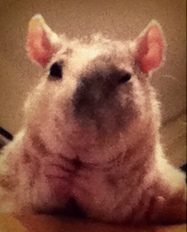
Commercially made Seed and Nut Mixes aren’t good sources of nutrition for pet rats. They definitely don’t work well as a mainstay since most rats will eat only their favorite ingredients, leaving out the rest. Thus, since only some of the ingredients in the mix are consumed, the diet becomes nutritionally incomplete. Even if you feed mostly lab blocks with a little seed and nut mix on the side, I’d still be concerned about ingredients in the mix being rancid and/or moldy.
Spinach: High in nitrates, cancer risk if fed frequently and in large quantities.
Turnip Greens: High in nitrates, cancer risk if fed frequently and in large quantities.
Wild Insects: Can carry diseases and can result in internal parasites.
Updated 8/12/16


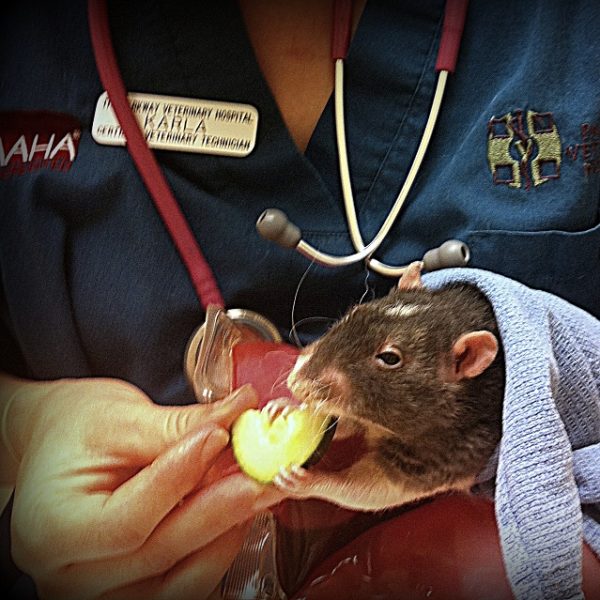
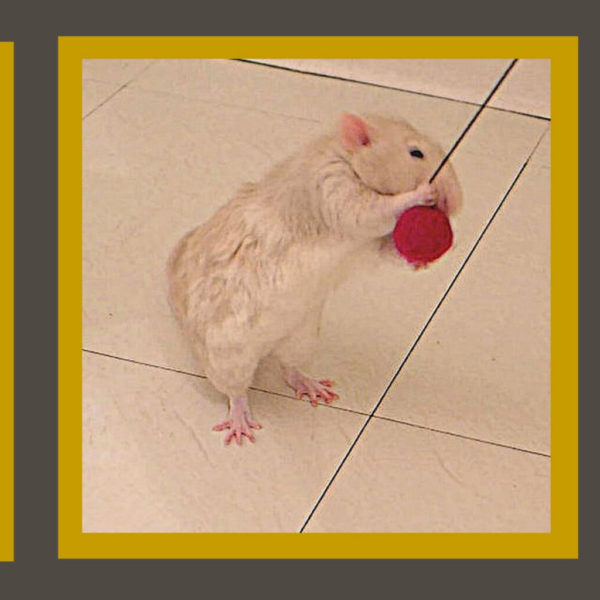


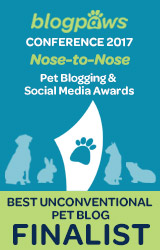
Hello,
while going over your list i got a bit…confused. I wanted rats for ever and I finally got 2 a few months ago. before getting rats however I went to my local Vet and asked questions as I wanted to make sure I had proper information and a place to take them to for any emergency’s before I adopt them. While looking at you food list I noticed you put :
• Spinach: High in nitrates, cancer risk if fed frequently and in large quantities
I don’t know if my vet advised me wrong but the team told me spinach was great for my rats especially if I add it to a mixture of other lettuces ( except Iceberg lettuce of course), kale, carrots and cucumbers. now I make sure that their regular dry food is the main course. ( I get Oxbow Essential Rat). I just don’t know if I was given bad advice or not. I grow my own “Rat” food in my garden, so they get the best I can give. ( I might be a little crazy about my rats haha). As I am doing more research I notice, everyone says different things about…. well all food that can either be given or not. I am trying to make a list to have on hand just so I can glance to make sure what I give is ok.
Thank you so much!
Mercede “Red” Hradec
Hi Mercede,
Thank you so much for asking your excellent question!
First of all, I want to say how impressed I am about the preparation and research you’re doing for your rats. You sound like a fantastic pet rat parent!
I completely understand how confusing it is when everyone is saying something different about what foods are unsafe for pet rats. I think the main thing to remember when it comes to spinach is that smaller quantities are fine, just don’t feed it in excess.
I haven’t yet added it to this page that spinach is also very high in oxalates which can contribute to kidney stones. (Thanks for showing me I need to make an update on this page!) I tend to favor kale and other dark leafy greens for my rats. Kale, for example, is low in oxaltes.
Everyone will say something different. I would stick with whatever your vet tells you. Then, with your research, consider all of the various ideas and suggestions. There isn’t always a black-and-white answer. My list is simply what I choose to avoid feeding my pet rats. The bottom line is, working with your veterinarian is best. (That is, as long as they’re a veterinarian who’s knowledgeable about and experienced with pet rats.)
Let me know if you need any clarification and/or have any additional questions.
Best Wishes to You & Your Rats,
Jasmine | About Pet Rats
Hi I have two rats x I love them so much x but unfortunately one of them has a lump on her chest 😢 been to the vet and it’s in a very dangerous place in her body so they can’t operate we have pain medication for her x I want them both to have the best life can you give me any advice on safe and good food for them x thanks 🙏🏻 Jen x
Hi Jennifer,
I’m so sorry to hear your rat has a lump on her chest and that your vet says it’s in a location where it can’t be removed.
I applaud you for taking her to the vet and for wanting to do everything you can to keep her comfortable.
Regarding food, you wouldn’t need to change her diet unless the tumor has grown so large she can’t hold food with her hands. I’m a bit unclear on whether or not you want to know about best rat diets in general or food that can be easily consumed when the size of her mass doesn’t allow her to use her hands.
I do have pages on commercial diets and a typical day’s diet. If she’s unable to use her hands, however, it would be best to give her soft food. You can soak her normal food in water so it becomes a “mush”. You can also break it into smaller pieces so she can just pick it up with her mouth. (This works well for the Oxbow kibble mentioned on my commercial diet page.) If she’s not able to put her head down to get food out of a dish, you can raise the dish so it’s at an appropriate level for her capabilities. One way to do this is to take a small water bowl and turn it upside down. Then you can place her food on top of the upside down water bowl.
I hope these ideas are helpful. If I’ve misunderstood your question and/or if you’d like to provide additional details, I’ll be glad to help further.
Sending love and positive thoughts to you and your rats,
Jasmine | About Pet Rats
Hi! My family recently tried a new type of pasta based with edamame. While it was ok, we don’t really want to eat the leftovers but don’t want to throw them out. Is it safe to feed to rats?
Thanks,
Willa.
Hi Willa,
Yes, edamame is fine for pet rats to eat. Just don’t feed them too much of it and make sure 80% of their diet is comprised of a high quality commercial rat diet.
Also, about not feeding them too much of it: Make sure they’re not able to gobble up a lot all at once—especially if it’s sticky pasta. Some rats can choke easily when you feed them any type of food that’s sticky. The funnest type of pasta to feed pet rats is a piece of a single strand of spaghetti noodle since they usually hold it like a fire hose and nibble it from one end.
Best Wishes to You & Your Rats!
Jasmine | About Pet Rats
Hi im layla recently i have had a lot of strawberries and my mum thinks that there bad for rats is it safe to feed
Hi Layla,
Strawberries are great for rats. You just want to make sure they’re organic. (Otherwise the pesticides that were sprayed on the strawberries would be dangerous.)
Hope she loves them!
Best Wishes to You & Your Rats,
Jasmine | About Pet Rats
Hello, I toasted some garbanzo beans the other day for my rats. I have been giving them one each day as a treat and gave them one tonight…then noticed they had started growing mold. I immediately ripped them out of their poor little mouths and gave them something else. The mold has me worried because I know I didn’t the whole bean out of their mouths. any advice? They are the sweetest girls and I feel terrible!!
Hi Heather,
I sympathize with your feeling terrible—You were making such a healthy snack for your girls and obviously didn’t intentionally mean to feed them moldy food. Hopefully they only ingested a tiny amount.
If it were a cat or dog AND if they’d eaten a substantial quantity, most vets would recommend inducing vomiting. With rats, however, they’re unable to vomit (due to their anatomy) so this wouldn’t be an option. As long as you don’t see any symptoms such as lethargy, diarrhea, excessive thirst or anything else out of the ordinary, your rats are probably fine. If you do see any symptoms, take them to the vet immediately. One of the things a vet might do would be to give subcutaneous fluids which could potentially help dilute any toxic effects.
At least you noticed the mold and were able to prevent them from continuing to eat the beans.
Sending best wishes to you & your rats!
Jasmine | About Pet Rats
Are squirrel peanuts okay for rats?
Hi Carleen,
Peanuts are okay but they’re not great. For one thing, nuts are very high in fat. Also, sometimes the shells grow mold on them (if you’re giving them the nuts in the shell).
You could give them a peanut every once in awhile as a special treat, but I don’t recommend it as something they should eat daily.
Let me know if you have any other questions.
Best Wishes to You & Your Rats,
Jasmine | About Pet Rats
I just adopted a pet rat, this is my first one. I started to give her bits and pieces of normal food (Veggies, cheese, fruit, nuts, etc.).. But now she doesn’t eat her rat food. I basically only feed her human food, I always leave a big bowl of rat food in her cage (its an assortment from petsmart, and she only picks a few things to eat from there). Do you think it is okay that I basically only feed her human food? I try to do a variety like steamed broccoli, cheese, grapes, rice, noodles, etc. or leftovers frommy meals.She has also gotten a bit chunky since I got her too though..
Hi There, Lana!
Thanks for asking your excellent question. Your rat needs a good quality diet made specifically for pet rats which can then be augmented with fresh, whole foods. The balance should be around 80% commercial rat diet with the remaining 20% as fresh, whole foods. When feeding your rat foods other than the commercial diet, organic is highly preferred.
I have a few links on my website that will give you more information on the best diets for your rat:
Commercial Diets
Variety & Supplements
A Typical Day’s Diet
The assortment of food you got from Petsmart is probably not one you’ll want to continue feeding. As you described, it’s too easy to pick out the favored foods in the mix and then leave the rest. Most of the commercially made mixes found in pet stores contain low-quality ingredients. Even if they were a higher caliber, your rat would need to eat all of the ingredients in order for a mix to be nutritionally complete.
Keeping them at a good weight can sometimes be difficult since rats are such foodies. It’s important to do your best at keeping her slim and trim since she’ll then be more likely enjoy a longer, healthier life. I would gradually switch her over to the Oxbow Essentials Adult Rat Food or, if she’s under 6-8 months, the Harlan Teklad 8604 would be a good choice. (Both of these are listed on my Commercial Diets page, including where you can buy them online.)
Make sure to get her a friend. While rats love being with humans, it’s essential they have rat friends, too. Here’s a post I think you’ll find useful: What to do when you’re down to one.
I hope my response is helpful to you. Don’t hesitate to let me know if you need clarification on anything or if you have any other questions.
Best Wishes to You & Your Rat,
Jasmine | About Pet Rats
However, I’ve noticed that after a while, rats will begin to trust their owners and eat all of the food without testing it more and more frequently.
That’s interesting, Romana. I’ve had rats who will eat just about anything and others who are as finicky as cats. :)
Thanks for sharing your perspective!
Jasmine | About Pet Rats
Great info here! My son is new to rats and so am I. Thank you!
Hi Mary Kay,
I’m so glad the information on my website is helpful for you. How exciting that you and your son are new to pet rats. You’re in for some fun times!
In case you’re not aware, you’re welcome to sign up for our newsletter. When you do so, you automatically receive your free Guide to Essential Pet Rat Supplies and have the opportunity to participate in pet rat supply giveaways. You can sign up HERE.
Don’t hesitate to let me know if you have any questions at any time.
Welcome to the Wonderful World of Pet Rats!
Jasmine | About Pet Rats
I have a rat and I dont know the best way to handle a rat so he doesn’t freak out I have tried since he was 2 months old and now he’s over a year old and he still seem scared does anyone have any ideas.
Hi Cindy,
Have you read the post Transforming Your Rat: From Shy to Social Butterfly yet? I think you’ll find some ideas that may be helpful for you and your rat there. If you have further questions after reading the post, don’t hesitate to let me know. Also, check out Bonding with Your Pet Rats in 3 Easy Steps.
Let me know how it goes and if you have more questions.
Best Wishes to You & Your Rat,
Jasmine | About Pet Rats
I had been wanting A Rat for a long time and finally made the leap. I bought two girls and brought them home. One was black and white and I named her Molly she was so sweet, the other one I named Lilly. Three days after I brought the girls home I got up to go to work and feed the girls petted them and went to get ready for work. Joe came to the bathroom and said have you seen Molly, how shes all stretched out.
I came to check on the girls and Molly was dead. So I gathered up Lilly and poor Molly and headed back to the pet store. They offered my money back for Molly and I said no I want another baby. I was told I would have to wait for another shipment to get one. Then they had to buy Lilly back because they could not care for a sick animal that belonged to me! After they had sold her to me! They took my Lilly and put her in isolation in the back of the store and she stayed there for two solid weeks. I was not able to see her or hold her. At the end of the two weeks my Lilly was a totally different rat. That time had changed her personality!
Now to my point I was told she had a respiratory infection and was treated with an antibiotic. I also found out that all rats outside the labs have mycoplasma contracted at birth from their mothers. Is this true?
Hi Tina,
Yes, it is true that almost all rats have mycoplasma from birth whether or not they exhibit symptoms.
Were you able to get Lilly back and help her return to her friendlier self? Also, were you able to get a new friend for her?
I believe it’s extremely important to take all new rats in for an exam by a veterinarian who’s knowledgeable AND experienced with pet rats. Taking your rats in for regular exams will help in assessing any illnesses (such as mycoplasma) which can then be addressed sooner rather than later, resulting in healthier rats (and a smaller vet bill).
I hope my response is helpful for you. Don’t hesitate to let me know if you have any additional questions.
I hope Lilly is doing well!
Best Wishes,
Jasmine | About Pet Rats
I adopted my Indie, a neutered adult male, a year ago from the Humane Society. He is my first rat. I feed him Kaytee rat block and veggies and fruits. I had never had a rat before so I had to do a lot of research. In April I bought Skye from a pet store. She was only about 3-4 weeks old. Indie and Skye get along very well, sleep together, and groom each other. I did not know about different diets for babies and adults. I have been feeding them both the same diet. What should I do? Can Skye thrive on this diet? All I have available in my pet store is Kaytee.
Hi Diana,
Your question is a great one! Babies should have more protein in their diets up until about 6-8 months for females and 8-10 months for males.
It is very difficult to feed rats with such diverse nutritional requirements when they’re living together. I’d suggest you feed both types of diets and do your best to make sure Indie gets his adult food and Skye primarily gets her food for growing female rats. One way you can do this is by having them stay in separate or a partitioned cage (along with their food) for a few hours each day. You can also observe when they’re about to eat and switch out the food whenever they begin munching on the wrong diet. Another way to help Skye get more protein is to give her a larger portion of meat, beans or tofu in her evening meal.
Kaytee isn’t the best food for pet rats. I’d recommend ordering your rats’ food online. My preference is the Oxbow diets. Oxbow’s adult diet is called Regal Rat. They also make a Young Mouse & Rat Diet. However, unless you’re able to get Skye spayed, it would be better to feed her the Harlan Teklad 8604 until she’s 6-8 monhts old since soybeans are the first ingredients listed.
If you’re able to find a veterinarian in your area who’s very experienced and knowledgeable about pet rats, I highly encourage you to have Skye spayed. Spaying greatly reduces the chances of mammary tumors in female rats which otherwise are a common occurrence.
That’s great they’re getting along so well!
I want to apologize for not getting back to you sooner. I was attending a conference this week and got way behind on responding.
Don’t hesitate to let me know if you have any other questions. In the future. I promise I’ll respond more quickly.
Best Wishes to You, Indie & Skye,
Jasmine | About Pet Rats
I know I’m a little late to the conversation, but I just got my first rat! I got the only type of rat food in my local pet store. And it has dried corn in it! What food do you recommend, where can I order it, and is it safe to keep feeding my new baby this food while it ships?
Thanks
Hi Kate,
CongRATulations on your new rat baby!
You’re not at all late to the conversation. The discussions here are ongoing. New comments and questions are always welcome.
For babies (up to 8 months), I’d recommend feeding the Harlan Teklad 8604, especially if your baby is female. Soybean meal, listed as the first ingredient, is particularly beneficial for unspayed females. In addition the Harlan Teklad 8604 diet has a protein content of 24.3%, which is a healthy level of protein for babies.
My second choice would be the Oxbow Essentials – Mouse and Young Rat diet. This reason this diet is my second choice is because the first ingredient listed is corn (instead of soybeans). Also, the protein level is 18% instead of the Harlan Teklad 8604 protein percentage of 24%.
You can order both of these diets online by clicking on the links provided above.
Harlan Teklad diets aren’t available in retail stores. However, you may be able to find the Oxbow Essentials – Mouse and Young Rat diet in a local store. Petsmart and Petco often carry this diet as do many exotic veterinarian offices. If your local humane society rescues and adopts out rats, they also may have a store where they sell the Oxbow diets. The Oxbow Animal Health website has a Find Oxbow Products link to help you find a local retailer. If you do order the Harlan Teklad 8604, you can feed the Oxbow diet in the meantime if you’re able to find it locally. You can also choose to feed both diets.
I would not continue to feed your baby the mix you currently have. If it contains dried corn, it sounds like it’s a seed mix. Besides the corn, seed mixes contain other ingredients that aren’t healthy for pet rats. In addition, most rats will pick and choose what they want to eat from a seed mix so they never receive a nutritionally balanced serving. For this same reason, I don’t recommend feeding Debbie Ducommun’s homemade diet since most rats won’t eat everything included in the diet.
In case it’s helpful for the future, details about all of the current best diets available for pet rats are included on my Commercial Diets page (found under the Nutrition tab).
I can’t help but ask: Is your new rat baby living with a friend? You may already be familiar that it’s very important to have at least two rats at a time. I have several posts about this you might find helpful on this topic. Here are two that come to mind:
I hope my responses here are helpful. If you need any further information, don’t hesitate to ask. I’m always here for you and your rats!
Best Wishes,
Jasmine | About Pet Rats
I’m pretty upset with the local pet store. They said my rat was male, but she has no male genitalia that I can see. They told me that you should only have one, or they’ll fight. And they sold me food that could apparently kill her.
Pet stores can give out false information whether knowingly or unknowingly. The important thing is that you now have the power to take the best care possible of your rat. Don’t hesitate to let me know if you have any other questions with which I can help. Rats are such great pets and I’m excited for you with your new baby and hope you’re able to get her a friend. :)
Best Wishes to You & Your Rat (& future rat friend for your new rat),
Jasmine | About Pet Rats
A note on their lack of a gallbladder:
Even though they do not have a gallbladder, they still produce the enzymes necessary to break down fats, as these are made by the liver. The gallbladder is just a storage site, so the bile that it stores in humans flows directly into the intestines constantly in rats.
So really, fat from meat if fine to feed rats, but not recommended cause it isn’t overly healthy for them :)
Hi Teaghan,
Thanks for your excellent comment. Great point that the liver produces the bile acids and the gallbladder stores them. Without a gall bladder, however, the amount of bile acids available for digestion at any given time is greatly reduced.
After doing a little further research I learned that rats’ livers secrete muricholic acid (a bile acid) directly into their intestines which helps them eliminate cholesterol. The article I read presents the case that rats shouldn’t be used for laboratory experiments since their physiology (and test results) are quite different from humans. In case you’re interested, here’s the article: Rats: Test Results that Don’t Apply to Humans.
I agree that fats from meats (and dairy products, too,) aren’t that healthy for rats. Your comment is so much appreciated and brought to my attention the importance of being as specific as possible. I’m considering some revisions to this page thanks to your great comment!
Best Wishes,
Jasmine | About Pet Rats
I recently bought two male rats, I was told they could not have any vitamin c, is this true?
Hi Kaitlyn,
First of all, congratulations on your two new rats! That’s exciting!
Regarding Vitamin C, if you look above on this page (Dangerous Foods) you’ll find it listed alphabetically under the heading “Citrus Juice”. Here’s the information posted above in case it’s difficult to find:
Let me know if I’ve misunderstood your question and don’t hesitate to let me know if you have any other questions. I’m happy to help anytime!
Best Wishes to You & Your New Rats,
Jasmine | About Pet Rats
I recently bought a rat muesli mix that has Meat & Fish Extrusions in, these have milk and milk derivatives in. Will that be okay?
In addition the muesli mix has flaked soy beans in…are they okay to eat?
Looking forward to your response/s.
Tom
Hi Tom,
Thanks for your great question!
Dairy products aren’t advised for adult pet rats. Besides being unnecessary, dairy is difficult to digest and can cause food allergies. However, cooked soy beans are a very healthy food for our rats.
Are all of the ingredients in the rat muesli mix processed? That would be my first concern. If you’re feeding your rats a good quality lab block (which is already a processed food), it’s best to supplement their diet with organic, whole foods including fresh fruits and vegetables.
I hope my response is helpful. You sound like a wonderful rat parent! Don’t hesitate to let me know if you have any other questions.
Best Wishes to You & Your Rats,
Jasmine | About Pet Rats
Thanks Jasmine.
I’ll remove the Meat & Fish Extrusions then.
Not all the muesli is processed, there are some seeds, and oats in it too. Our diet for our rats will consist of 80%(ish) mix – rat muesli and rat nuggets mixed together) and the rest will be fruit and vege and a few wholegrain carbs and the odd chicken bone or something like that now and again…any tips?
Thank you.
Tom
Hi Tom,
In my opinion, the best diet for our pet rats includes:
80%= A high quality lab block (Such as Harlan Teklad—also known as Native Earth—or Oxbow Essentials) For a complete listing of which diets are best for males/females/babies/adults and where to find them, you’re welcome to sign up here for my Guide to Essential Pet Rat Supplies—if you haven’t already done so.
20%= Organic fruits and vegetables and very small amounts of any healthy food from your own meals; Tofu and edamame beans are especially helpful to add to the diets of unspayed female rats
I, personally, am a big fan of Green Mush. When I first started feeding Green Mush I had male rats and they lived, on average, a year longer than my previous males.
The muesli mix you describe may be a bit similar to the organic grain mix I place on top of my rats’ Green Mush each morning. You can find my grain mix recipe here.
The only thing better than the above diet would be to feed Debbie Ducommon’s homemade diet. (Scroll to bottom to view her diet.) I would love to feed my rats her diet. However, whenever I’ve tried her diet in the past, my rats didn’t eat all of the food specified each day making it incomplete. Because of this, I feed the highest quality lab blocks combined with organic foods such as those listed in Debbie Ducommon’s pet rat diet.
Again, it’s wonderful to see you’re carefully researching your pet rats’ diet. Nutrition is such a vital part of maintaining our pet rats’ health.
Don’t hesitate to let me know if you have any other questions.
Best Wishes to You & Your Rats,
Jasmine Bachrach | About Pet Rats
A note on chocolate: Although it can be deadly to dogs, chocolate is fine for rats, and as mentioned, it contains methylxanthines (in particular, caffeine and theobromine), which are bronchodilators that can actually be helpful to a rat with respiratory problems. The main reasons to go easy on the chocolate with rats are (a) the sugar and (b) the milk content. Adult rats are lactose-intolerant, so it’s best to avoid milk chocolate and give them only dark chocolate–such as the 70% variety that a lot of brands have.
Hi Paul,
Thanks for stopping by and commenting on whether or not it’s safe to give chocolate to our pet rats. You raise excellent points and provide very helpful details.
It’s true that some people do give their rats chocolate, particularly when they are in respiratory distress. Personally, I still choose not to do so since there are so many other equally or even more effective and longer lasting treatment options. Chocolate can, in high doses, cause neurological damage and/or lead to heart failure. In my opinion, why risk it?
That said, it’s definitely a personal choice. I appreciate your pointing out the bronchodilating properties of the methylxanthines caffeine and theobromine found in chocolate. It’s also helpful, for anyone who does choose to feed their rat chocolate, that you mentioned to give only dark chocolate.
You sound very knowledgeable—hope to hear more from you!
Jasmine | About Pet Rats
I think one of my rats may have eaten mouldy food! She has a small lump like a bruise behind her cheek, what should I do?! ;(
Mouldy food would not cause a mass to form. Instead, eating mouldy food would more likely result in symptoms such as loss of appetite and/or lethargy.
Your rat could have an abscessed tooth or a tumor in her ear. The most important thing right now is to take her in to be examined by a veterinarian who’s experienced with rats. This should be done as soon as possible. Your veterinarian will be able to determine the nature of the lump and will likely prescribe medication(s). Most often, antibiotics are prescribed for this type of problem. Sometimes anti-inflammatory medications are also prescribed in addition to others.
Unfortunately, most masses in a rat’s cheek area are not a good sign. Here are a few links that give information on facial masses:
http://www.ratfanclub.org/abscess.html (see 4th paragraph)
http://ratguide.com/health/neoplasia/zymbals_gland_tumor.php
I hope you can take her to the vet as soon as possible. I also hope it’s not too serious but, as I mentioned above, masses on the side of the face can indicate a serious health issue.
Don’t hesitate to let me know if I can help further.
Sending Positive Wishes to You and Your Rat,
Jasmine | About Pet Rats